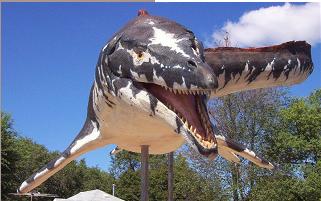A mosasaur was not a dinosaur, but rather an ocean-dwelling serpentine marine reptile more closely related to snakes than to monitor lizards (Lee 1997). These predators evolved from terrestrial ancestors in the early Cretaceous and dominated the oceanic food chain during the late Cretaceous Period.
Genera included Mosasaurus, Tylosaurus, and Platecarpus.
Genera included Mosasaurus, Tylosaurus, and Platecarpus.
Mosasaurs breathed air, but were powerful swimmers, so well adapted to living in shallow seas that they gave birth to live young, rather than return to the shoreline to lay eggs, as sea turtles do. Mosasaurs likely descended from varanid lizards.
The smallest known mosasaur is Carinodens belgicus, which was about 3 to 3.5 m long and probably lived on the sea floor cracking mollusks and sea urchins with its bulbous teeth. Larger mosasaurs were more typical: mosasaurs ranged in size up to 17 m: Hainosaurus holds the record for longest mosasaur, at 17.5 m.
A mosasaur had a body form similar to that of a crocodile, although streamlined for fast swimming in marine waters. Their front leg bones were reduced in length, their paddles strengthened by long finger-bones. Their rear legs were atrophied. Their powerful tails, lashed side to side crocodile-fashion, provided locomotion.
Mosasaurs had a loosely-hinged jaw which enabled them to gulp down their prey almost whole, a snakelike habit that has helped identify the stomach contents fossilized within a Mosasaur skeleton, which included the diving seabird Hesperornis, a marine bony fish, a shark, and part of a smaller mosasaur. Mosasaur bones have been found with embedded shark teeth.
The smallest known mosasaur is Carinodens belgicus, which was about 3 to 3.5 m long and probably lived on the sea floor cracking mollusks and sea urchins with its bulbous teeth. Larger mosasaurs were more typical: mosasaurs ranged in size up to 17 m: Hainosaurus holds the record for longest mosasaur, at 17.5 m.
A mosasaur had a body form similar to that of a crocodile, although streamlined for fast swimming in marine waters. Their front leg bones were reduced in length, their paddles strengthened by long finger-bones. Their rear legs were atrophied. Their powerful tails, lashed side to side crocodile-fashion, provided locomotion.
Mosasaurs had a loosely-hinged jaw which enabled them to gulp down their prey almost whole, a snakelike habit that has helped identify the stomach contents fossilized within a Mosasaur skeleton, which included the diving seabird Hesperornis, a marine bony fish, a shark, and part of a smaller mosasaur. Mosasaur bones have been found with embedded shark teeth.
[[Home]
[News] [Life-Size Sculptures] [Model Kits] [Wildlife Collection]
[Complete Catalog]
[About Us] [Contact Us]
[Frequent Questions] [The Studio At Work] [Links] [Privacy Policy] [Terms of Use]
mail@cmstudio.com
© 2017 CM Studio
All Rights Reserved
CM Studio 100 West Central Avenue Benld, Illinois 62009
[News] [Life-Size Sculptures] [Model Kits] [Wildlife Collection]
[Complete Catalog]
[About Us] [Contact Us]
[Frequent Questions] [The Studio At Work] [Links] [Privacy Policy] [Terms of Use]
mail@cmstudio.com
© 2017 CM Studio
All Rights Reserved
CM Studio 100 West Central Avenue Benld, Illinois 62009


